$10 National Bank Notes
The ten dollar national bank note is the most common denomination found on national currency. There are currently around 150,000 known to exist from all banks and across all types. While that may sound common, some ten dollar notes are exceptionally rare. As with any national bank note, the value is all based on the condition of the bill, serial number, type, and bank of issue. If you need more guidance, don’t hesitate to ask a question. Sales@AntiqueMoney.com
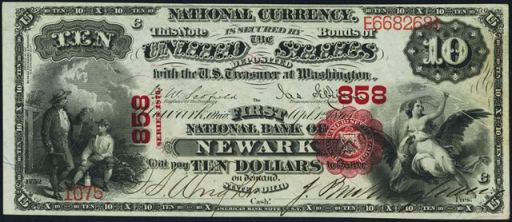
The earliest national bank notes are referred to as first charter period currency. Banks that issued first charter notes were typically found in larger cities. There were town population and bank capitalization requirements that many smaller areas just couldn’t meet.
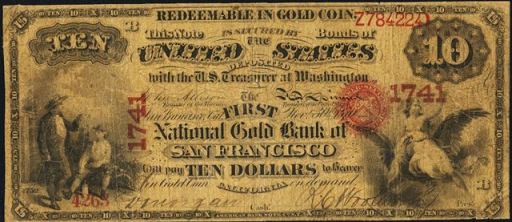
Ten dollar national gold bank notes are difficult to locate in nice condition. These notes circulated heavily in the post gold boom California. Gold backed notes were preferred to other non-metal currencies. Because of their preference, these traded hands frequently when compared to other paper money, that actually sometimes was not even worth face value.
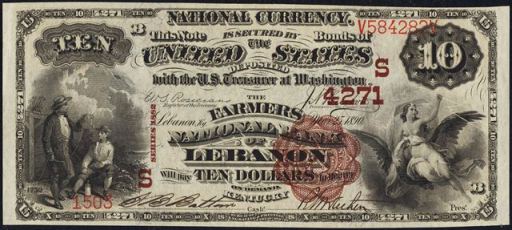
The series of 1882 notes look similar to the first charter notes shown above. However, the seals on 1882 notes are either brown or blue. The note pictured above is called a brown back by collectors. Brown backs are typically very popular. The design shows Benjamin Franklin flying a kite in a lightening storm. The year 1752 is printed under Franklin. That year sometimes confuses collectors into thinking that the note is actually from 1752.
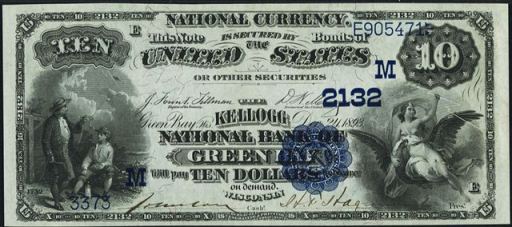
After brown backs ran their course, the 1882 date back was issued. 1882 date backs get their name because the back of each bill has the dates 1882 and 1908 printed on them. These issues are generally considered the least interesting ten dollar national bank notes. However, uninteresting does not necessarily mean non-valuable. There are plenty of rare issues even though the series is not popular.
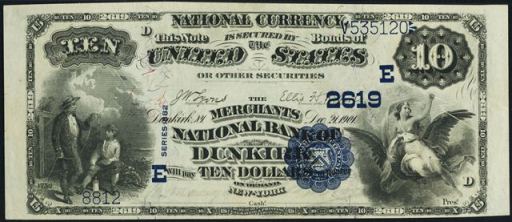
The final installment in the series of 1882 is called a value back. Some value backs can be very tough to locate. These are called value backs because the back of each bill has the value, “ten dollars” printed in large letters. 1,343 banks issued $10 value backs. Believe it or not, these were still being issued by some banks as late as 1921. So don’t just assume that because the bill says 1882 that it was actually printed then.
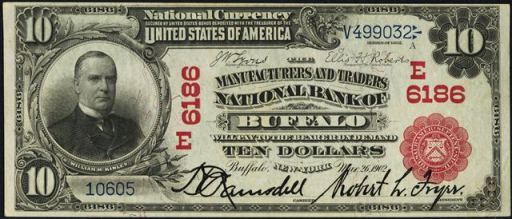
1902 $10 red seal national bank notes are always popular. In some cases they are only worth a few hundred dollars. However, more often than not, they are worth at least a couple thousand dollars and up. Many banks that issued red seals were chartered between 1902 and 1908. These same banks never really got big enough during that period to issue much money. Some banks might have only issued a few hundred red seals; as you can imagine, the survival rate is very weak at that level.
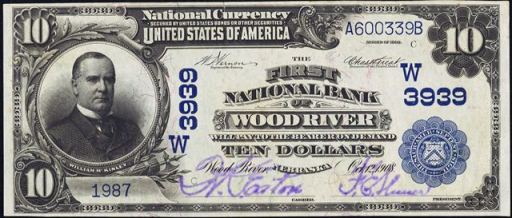
Ten dollar blue seals from the series of 1902 are by far the most common large size national bank note. However, based on the bank of issue, some $10 notes can be extremely valuable. If the serial number below William McKinley is 1, then there will be an additional premium. These notes were printed up until 1929. I see lots of 1902 tens, some are rare, some are not. Just send me a picture of what you have and I can tell you if it is rare.
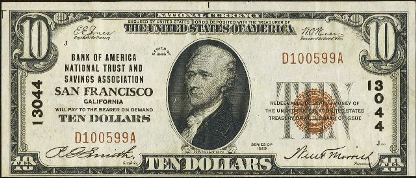
As I think I have established, small size 1929 $10 national bank notes tend to be common. Notes like the one above that have a long serial number will almost certainly be worth less than $100. If your note has a serial number under 1000 then it has a good chance to be worth a few hundred dollars or more.
If you need help valuing your ten dollar national bank note, just ask. I would be happy to help and I am an aggressive buyer. Sales@AntiqueMoney.com


